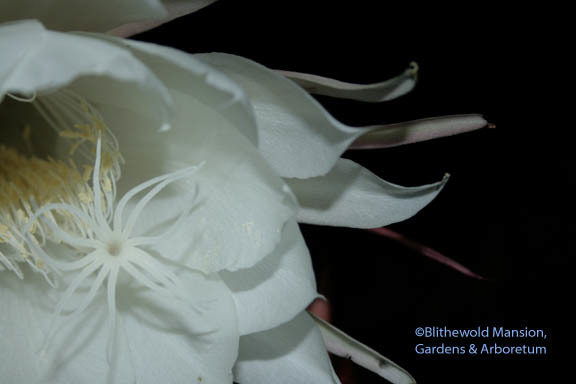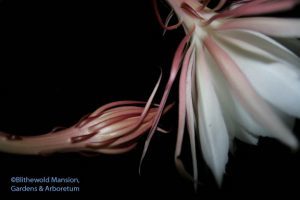Night Blooming Cereus

Night Blooming Cereus
One hundred years ago, on August 1, 1916, The Bristol Phoenix announced to the town that a rare horticultural event was taking place at Blithewold. Bessie had been cultivating a Night Blooming Cereus in the greenhouse since 1901, tending it and encouraging it, until at last, in August 1916, it passed all expectations in a magnificent show of blooms. For three days the plant sent out new blossoms, thrilling all Bessie’s horticultural friends in the town. The newspaper reported:
Night Blooming Cereus -A Huge Plant at Blithewold has 85 Blooms in One Night
Bristol Phoenix – August 1, 1916
A gigantic night blooming cereus has been sending out its large and beautiful blossoms in the conservatory of Mr. and Mrs. William L. McKee at Blithewold during the past three or four nights. The plant is 15 years old and has been blossoming for several seasons, about this time of year. It is enormous in size, covering all of one end of a room in the conservatory. Last Friday night the plant began to blossom sending out 14 blooms; on Saturday night not less than 85 blooms appeared, almost covering the plant with the large white flowers, and sending out a strong but pleasing odor. It was a wonderful sight. On Sunday night there were 26 blooms on the plant.
The night blooming Cereus is of the cactus family known as Phyllacactus, and is mostly epiphytic, the joints being flat and becoming thin and leaf-like upon cylindrical stems. About a dozen species are recognized in Central and South America. The color of the blossoms is white, with delicate yellow centers. They bloom only at night, the blossoms closing to open no more as soon as daylight appears. 
A Night Blooming Cereus still grows at
Blithewold. Visitors can see a large specimen under the arbor next to the Pump House at the north end of the property.
Margaret Whitehead
